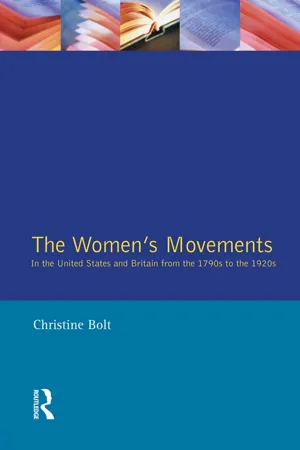History
Women and Progressivism
Women played a significant role in the Progressive Era, advocating for social and political reforms such as suffrage, labor rights, and social welfare. They organized and participated in movements to address issues like child labor, education, and public health. Their activism and advocacy contributed to significant legislative and societal changes, marking a pivotal period in the advancement of women's rights and social progress.
Written by Perlego with AI-assistance
Related key terms
1 Key excerpts on "Women and Progressivism"
- Christine Bolt(Author)
- 2014(Publication Date)
- Routledge(Publisher)
5The women’s movements in maturity The 1890s to 1914I n the years between 1890 and World War One, American and British feminists experienced more success and sharper disappointments than at any period since Seneca Falls. American women achieved their biggest gains as reformers by preparing the ground for and shaping the movement known as Progressivism, which was dominated by the concerns that women had been seeking to make their own since the Civil War: greater democracy, better educational provision, the protection of women and children, and the alleviation of urban problems with a view to bridging the class divide. Women’s claims to a public role in reform were fully recognised for the first time, and their ability to act was increased from the 1890s onwards by creating new separatist organisations and expanding old ones. Working-class women, though willing to co-operate with their middle-class sisters in union formation, were playing a more independent part in cross-class and working-class associations. Even the women’s suffrage campaigners made real gains, broadening their base of support, adopting bold new techniques and winning the vote in additional states.Yet the franchise still eluded American feminists nationally, and their opponents had become more vocal, though not the organisational equals of the suffragists. There was also a danger that as Progressive reformers women would become indistinguishable from other Progressives, or at least unduly shaped by the pressures of non-feminist colleagues. As Hart reminds us, some effective women bureaucrats did emerge, and were linked to an outside network of feminists; but the passage of reformist laws was often hailed without sufficient attention to the bureaucracies that would administer them. Moreover, anticipating the open divisions in the women’s cause after 1920, there were signs of a challenge to the broad consensus about women’s distinctive characteristics that feminists had turned from a liability, confining them within a subordinate sphere, to a building block for their movement. The first challenge was offered by the ‘new woman’ of the 1890s, whose independent lifestyle and (in some cases) views on moral issues minimised the differences between the sexes, and were taken up by feminists who now gave themselves that label, in the 1910s. The second came from scholars, women among them, who questioned the Victorian elevation of biology over culture and ‘the Victorian conception of sexual polarity’, and whose views slowly influenced the country’s college population.1
Learn about this page
Index pages curate the most relevant extracts from our library of academic textbooks. They’ve been created using an in-house natural language model (NLM), each adding context and meaning to key research topics.
